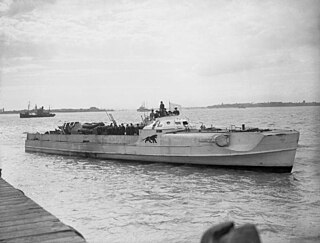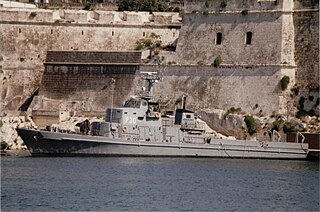
The Royal Norwegian Navy is the branch of the Norwegian Armed Forces responsible for naval operations of Norway. As of 2008, the Royal Norwegian Navy consists of approximately 3,700 personnel and 70 vessels, including 4 heavy frigates, 6 submarines, 14 patrol boats, 4 minesweepers, 4 minehunters, 1 mine detection vessel, 4 support vessels and 2 training vessels. It also includes the Coast Guard.

A corvette is a small warship. It is traditionally the smallest class of vessel considered to be a proper warship. The warship class above the corvette is that of the frigate, while the class below was historically that of the sloop-of-war. The modern types of ships below a corvette are coastal patrol craft, missile boat and fast attack craft. In modern terms, a corvette is typically between 500 tons and 2,000 tons, although recent designs may approach 3,000 tons, which might instead be considered a small frigate.
A patrol boat is a relatively small naval vessel generally designed for coastal defence, border protection, immigration law-enforcement, search and rescue duties. There have been many designs for patrol boats. They may be operated by a nation's navy, coast guard, police force or customs and may be intended for marine or estuarine or river environments. They are commonly found engaged in various border protection roles, including anti-smuggling, anti-piracy, fisheries patrols, and immigration law enforcement. They are also often called upon to participate in rescue operations.

E-boat was the Western Allies' designation for the fast attack craft of the Kriegsmarine during World War II; E-boat could refer to a patrol craft from an armed motorboat to a large Torpedoboot.

Skjold-class corvettes are a class of six light, superfast, stealth missile corvettes in service with the Royal Norwegian Navy. The boats were formerly classed as MTBs but, from 2009, the Royal Norwegian Navy has described them as corvettes (korvett) because their seaworthiness is seen as comparable to corvettes, and because they do not carry torpedoes. They were built at the Umoe Mandal yard. With a maximum speed of 60 knots (110 km/h), the Skjold-class corvettes were the fastest combat ships afloat at the time of their introduction.

The Hauk-class patrol boats were a series of Norwegian fast attack craft. Hauk means hawk in Norwegian. They were ordered in the 1970s and the first boat, Hauk, was commissioned on 17 August 1977. Designed as a development of the Storm and Snøgg classes, by Lieutenant commander Harald Henriksen, the 14 Hauk-class vessels made up the Coastal Combat Flotilla, responsible for protecting the rugged coastline of Norway. The ships were modernized frequently and in their later form were known as "Super-Hauks." The Royal Norwegian Navy deployed four of these warships for anti-terror patrol in the Strait of Gibraltar.

Whiskey-class submarines are a class of diesel-electric attack submarines that the Soviet Union built in the early Cold War period.

Pohjanmaa is a former minelayer of the Finnish Navy. The sole member of her class, she was the flagship of the Finnish Navy as well as the largest naval ship in service in Finland until 2013. The ship has a Finnish-Swedish ice class 1A so she can operate all year round. During a crisis, the main task for Pohjanmaa would have been mine laying and acting as a command ship. She also acted as a school ship for the Naval Academy cadets. Part of their training includes an annual cruise abroad.
The Snøgg class was a Royal Norwegian Navy class of fast patrol boats (FPB). It might also be classified as a torpedo boat or a missile boat. In Norway this type of vessel is called a missile torpedo boat (MTB). The class was named after its lead vessel, Snøgg, which is a Norwegian word meaning "fast". All of the subsequent names are synonyms of "fast".

HNoMS Draug was the lead ship of the three-ship Draug class of destroyers built for the Royal Norwegian Navy in the years 1908–1913. The four-stacked destroyer was kept in service long after she was obsolete, and took part in the defence of Norway during the German invasion in 1940.

The Belgian Navy, officially the Belgian Naval Component of the Belgian Armed Forces, is the naval service of Belgium.

The Project 205 Moskit (mosquito) more commonly known by their NATO reporting name Osa, are a class of missile boats developed for the Soviet Navy in the late 1950s. Until 1962 this was classified as a large torpedo boat.

Coastal Forces was a division of the Royal Navy initially established during World War I, and then again in World War II under the command of Rear-Admiral, Coastal Forces. It remained active until the last minesweepers to wear the "HM Coastal Forces" cap tally were taken out of reserve in 1968. In 2020, 1st Patrol Boat Squadron was restructured as Coastal Forces Squadron encompassing the Archer-class patrol vessels and the Batch 1 River-class offshore patrol vessels and are responsible for UKEEZ Protection and Patrol.

The Lithuanian Navy is the naval arm of the Lithuanian Armed Forces. Though formally established on 1 August 1935 its roots stretch back as far as naval engagements on the Baltic Sea in the Medieval period. Lithuanian naval units saw some service with Soviet naval forces during World War II, and the navy has been re-established in its own right and continues to expand since Lithuania's independence in 1990.

Linga was a Storm class patrol boat of the Latvian Naval Forces. It was built in Bergen, Norway, in 1967–1968 and originally served in the Royal Norwegian Navy under the name HNoMS Gnist.
MTB 345 was an experimental motor torpedo boat constructed in 1941, which saw limited service with the Royal Navy before being transferred to the exiled Royal Norwegian Navy on 16 March 1943. She sailed with the Royal Norwegian Navy for three months in 1943, until captured by German forces on 28 July 1943, during her second mission to the coast of occupied Norway. Two days after their capture, the crew of MTB 345 were executed by the Germans based on Hitler's Commando Order. Following their capture of MTB 345, the Germans pressed the motor torpedo boat into Kriegsmarine service, renaming her SA 12. The fate of SA 12 since December 1943 is unknown.

Project 89 Minesweeper, also known as the Kondor class, was a class of minesweepers designed in the German Democratic Republic which was given the NATO designation of "Kondor". There were 3 versions, namely, the prototype unit, Project 89.0; the first version, Project 89.1 ; and the second version, Project 89.2.

The Tjeld class was a class of twenty fast patrol boats designed and built for the Royal Norwegian Navy in the late 1950s. They were used as torpedo boats in Norway where this type of vessel were called MTBs or motor torpedo boats (motortorpedobåt). They remained in service until the late 1970s, when they were placed in reserve; all were stricken by 1995.


























